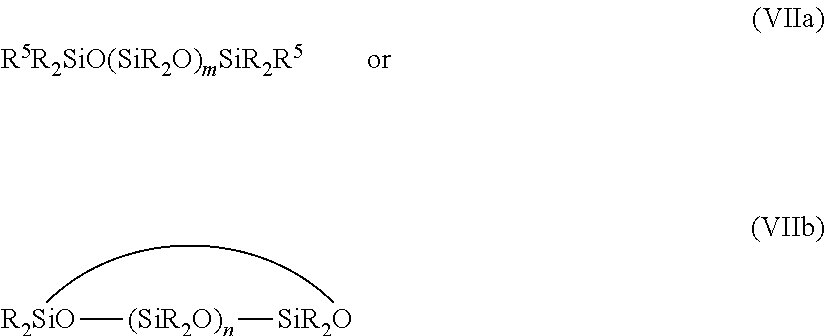Defoaming formulations containing organopolysiloxanes
a technology of organopolysiloxanes and degasification agents, which is applied in the direction of detergent compounding agents, liquid degasification, separation processes, etc., can solve the problems of poor reproducibility, formulations exhibit a large increase in viscosity, and the formation of foam can present problems, so as to increase the storage time of degasification compound, increase the viscosity, and increase the viscosity
- Summary
- Abstract
- Description
- Claims
- Application Information
AI Technical Summary
Benefits of technology
Problems solved by technology
Method used
Image
Examples
examples 1
[0249]Preparation of the Organosilicon Compounds (A):
[0250]a) Organosilicon Compound A1:
[0251]In a 500 ml three-necked flask, 101.0 g of an equilibrate of dimethylsiloxy and vinyldimethylsiloxy units having an iodine number of 22.0 with 2.7 g of a hydrolyzate of hydrogenmethyldichlorosilane terminated with trimethylsiloxy units and having a chain length of ca. 55 Si units, 120.0 g of an OH-terminated polydimethylsiloxane having a viscosity of 62 mm2 / s (25.0° C.; capillary no. II) and 28.6 g of an equilibrate of dimethylsiloxy and trimethylsiloxy units having a viscosity of 35 mm2 / s (25.0° C.; capillary no. II) are equilibrated for two hours with 250 ppm PNCl2 at 120° C. and a reduced pressure of 20 mbar. The catalyst is deactivated by addition of NaHCO3. After filtration and removal of volatile constituents at 160° C. and a reduced pressure of 40 mbar, a polysiloxane A1 having a viscosity of 81 mm2 / s (25.0° C.; capillary no. II), an iodine number of 13.3 and an H content of 0.016% b...
examples 2
[0256]Preparation of the Organopolysiloxanes (1):
[0257]a) Organopolysiloxane (1-1):
[0258]In a 250 ml three-necked flask 100.0 g of the polysiloxane A1 dissolved in 50 ml of xylene together with 0.2 g of a toluenic solution of Karstedt's Pt catalyst (Pt content: 0.3% by weight) are heated to 90° C. for 3.5 h. During the final cooling 0.3 g of diallyl maleate are added. Xylene is removed at 90° C. and under a reduced pressure of 32 mbar. A polysiloxane (1-1) having a viscosity of 425 mPa·s (measured at 25° C. and a shear rate of 1 1 / s) is obtained.
[0259]Preparation of organopolysiloxane (1-1) thus employs exclusively polysiloxane A1 and the predominant component present is therefore structural element (IV) where x=52. (1-1) is in the form of a flowable compound not inclined to gelling. It is thus not necessary to use an inert solvent.
[0260]b) Organopolysiloxane (1-2):
[0261]In a 250 ml three-necked flask, 100.0 g of the polysiloxane A2 together with 55.0 g of a linear vinyldimethylsily...
examples 3
[0270]Preparation of the Non-Inventive Defoamer Formulations VC1, VC2 and VC3 with the Organopolysiloxanes (1-3) and V1:
[0271]To prepare the defoamer formulations, the substances (1), (2), (3), (6), (7) and (9) described in Table 1 are mixed with a dissolver and heated to 150° C. for 4 hours. After cooling, components (5) and (8) are incorporated, again using the dissolver and homogenized.
[0272]General Procedure for Preparing the Inventive Defoamer Formulations C1-C21 with the Organopolysiloxanes (Variant 1):
[0273]To prepare the defoamer formulations, the substances (1), (2), (3), (4), (6), (7) and (9) described in Table 1 are mixed with a dissolver and heated to 150° C. for 4 hours. After cooling, components (5) and (8) are incorporated, again using the dissolver and homogenized.
[0274]The inventive defoamer formulations C1-C21 with the organopolysiloxanes can also be prepared as follows (variant 2):
[0275]To prepare the defoamer formulations, the substances (1), (2), (3), (6), (7) a...
PUM
| Property | Measurement | Unit |
|---|---|---|
| molar ratio | aaaaa | aaaaa |
| boiling point | aaaaa | aaaaa |
| frequency | aaaaa | aaaaa |
Abstract
Description
Claims
Application Information
 Login to View More
Login to View More - R&D
- Intellectual Property
- Life Sciences
- Materials
- Tech Scout
- Unparalleled Data Quality
- Higher Quality Content
- 60% Fewer Hallucinations
Browse by: Latest US Patents, China's latest patents, Technical Efficacy Thesaurus, Application Domain, Technology Topic, Popular Technical Reports.
© 2025 PatSnap. All rights reserved.Legal|Privacy policy|Modern Slavery Act Transparency Statement|Sitemap|About US| Contact US: help@patsnap.com


